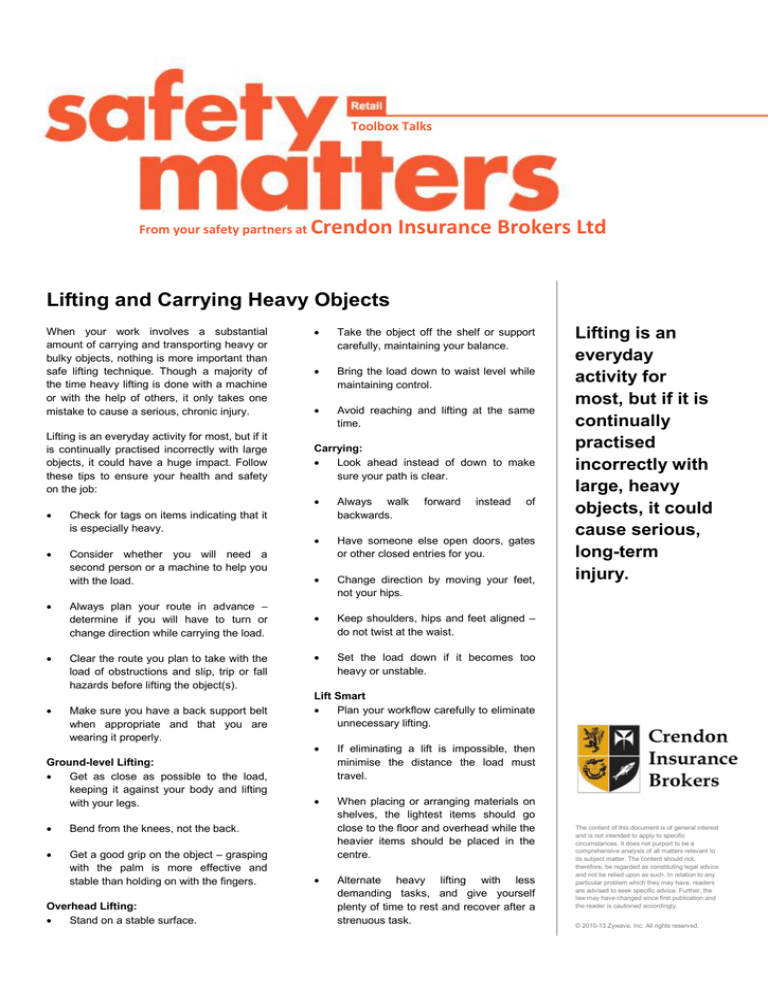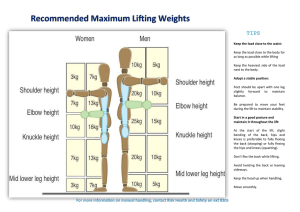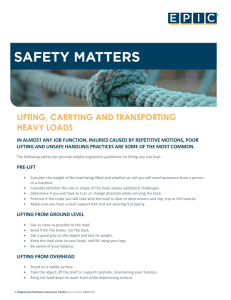
Toolbox Talks
From your safety partners at
Crendon Insurance Brokers Ltd
Lifting and Carrying Heavy Objects
When your work involves a substantial
amount of carrying and transporting heavy or
bulky objects, nothing is more important than
safe lifting technique. Though a majority of
the time heavy lifting is done with a machine
or with the help of others, it only takes one
mistake to cause a serious, chronic injury.
Lifting is an everyday activity for most, but if it
is continually practised incorrectly with large
objects, it could have a huge impact. Follow
these tips to ensure your health and safety
on the job:
Check for tags on items indicating that it
is especially heavy.
Consider whether you will need a
second person or a machine to help you
with the load.
Always plan your route in advance –
determine if you will have to turn or
change direction while carrying the load.
Clear the route you plan to take with the
load of obstructions and slip, trip or fall
hazards before lifting the object(s).
Make sure you have a back support belt
when appropriate and that you are
wearing it properly.
Ground-level Lifting:
Get as close as possible to the load,
keeping it against your body and lifting
with your legs.
Bend from the knees, not the back.
Get a good grip on the object – grasping
with the palm is more effective and
stable than holding on with the fingers.
Overhead Lifting:
Stand on a stable surface.
Take the object off the shelf or support
carefully, maintaining your balance.
Bring the load down to waist level while
maintaining control.
Avoid reaching and lifting at the same
time.
Carrying:
Look ahead instead of down to make
sure your path is clear.
Always walk
backwards.
Have someone else open doors, gates
or other closed entries for you.
Change direction by moving your feet,
not your hips.
Keep shoulders, hips and feet aligned –
do not twist at the waist.
Set the load down if it becomes too
heavy or unstable.
forward
instead
of
Lifting is an
everyday
activity for
most, but if it is
continually
practised
incorrectly with
large, heavy
objects, it could
cause serious,
long-term
injury.
Lift Smart
Plan your workflow carefully to eliminate
unnecessary lifting.
If eliminating a lift is impossible, then
minimise the distance the load must
travel.
When placing or arranging materials on
shelves, the lightest items should go
close to the floor and overhead while the
heavier items should be placed in the
centre.
Alternate heavy lifting with less
demanding tasks, and give yourself
plenty of time to rest and recover after a
strenuous task.
The content of this document is of general interest
and is not intended to apply to specific
circumstances. It does not purport to be a
comprehensive analysis of all matters relevant to
its subject matter. The content should not,
therefore, be regarded as constituting legal advice
and not be relied upon as such. In relation to any
particular problem which they may have, readers
are advised to seek specific advice. Further, the
law may have changed since first publication and
the reader is cautioned accordingly.
© 2010-13 Zywave, Inc. All rights reserved.




